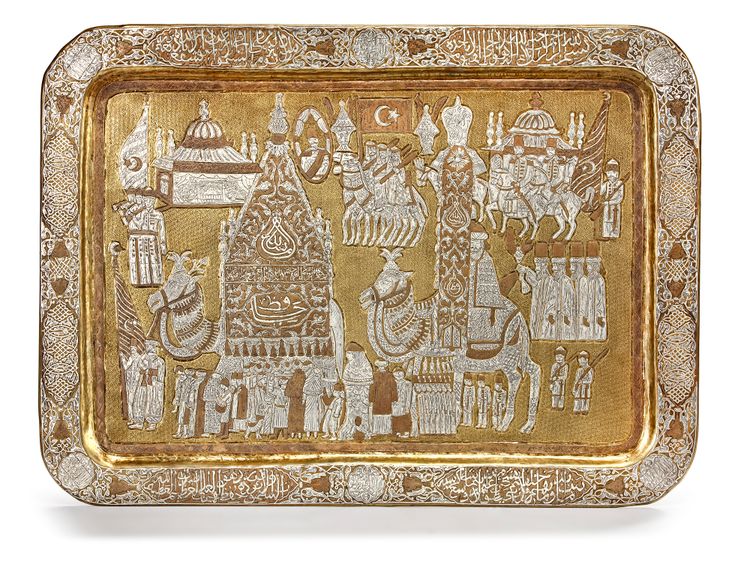Lot 216 A LARGE MAMLUK REVIVAL SILVER AND COPPER INLAID BRASS TRAY DEPICTING THE MAHMAL PROCESSION TO MECCA, SYRIA, 19TH CENTURY
A brass tray of rectangular form, profusely inlaid, the central field depicting the Mahmal procession, the border containing cartouches enclosing inscriptions in Thuluth script of Ayat Al-Kursi v. 255 from surah Al-Baqaraa with interspersed roundels containing bands enclosing kalimaat Al-Tawhid.
The tray is decorated with a scene representing the procession of the mahmal, most probably after leaving Damascus as it is clear that the caravan is accompanied by Bedouin tribes for their good knowledge of the desert routes and protection against thugs and other tribes.The mahmal is borne by a richly caparisoned camel. It is preceded by an official holding a flag bearing the Ottoman star-and-crescent motif, and followed by another riding a similarly caparisoned camel and carrying a banner (bayraq). Behind him is a group of religious figures wearing distinctive hats. Around them are groups of soldiers riding camels or on horseback, three musicians and some pilgrims, as well as spectators and well-wishers. In the back ground is Amir al-hajj "commander of the pilgrimage" with other officials.
74 by 54 cm.
The mahmal was the ceremonial palanquin carried on a camel, which was the centre of the pilgrim caravan, and was the symbol of authority of the sultan over the holy places. Its origins are uncertain: it might hark back to the tradition of a palanquin carrying a high-ranking female accompanying military campaigns for encouragement, a role the Prophet's wife was said to have had. The first sultan known to send the mahmal was Baybars (AD 1260-77). Following the Ottoman conquest of Egypt in 1517, the Ottomans also sent a mahmal from Damascus, as did the Yemenis on occasion. After the pilgrimage, the mahmal did not stay in Mecca, but was taken back to Cairo.




